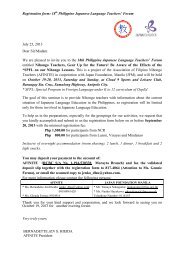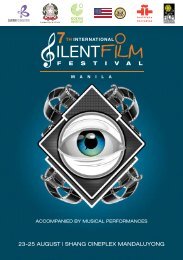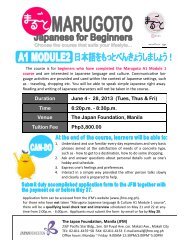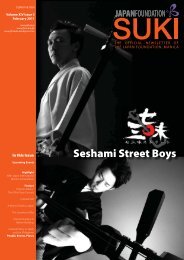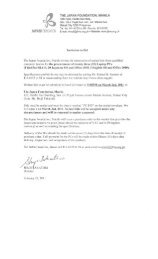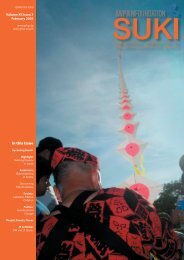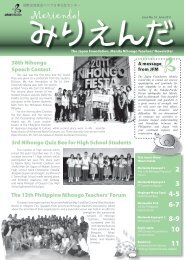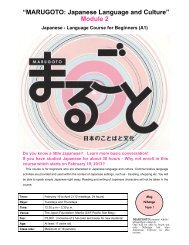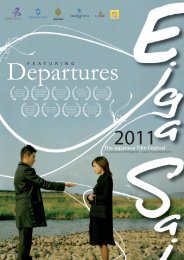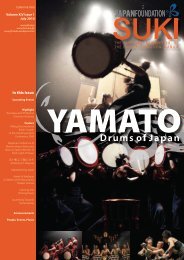Merienda! - The Japan Foundation, Manila
Merienda! - The Japan Foundation, Manila
Merienda! - The Japan Foundation, Manila
You also want an ePaper? Increase the reach of your titles
YUMPU automatically turns print PDFs into web optimized ePapers that Google loves.
ability.<strong>The</strong> next speaker was lively Prof. Pesimowho gave a passionate talk about the Filipino animeindustry. To know that 80% of the TOIEI workforce isfrom the Philippines is jaw-dropping. But then again,we’ve got Filipino animators at Walt Disney so I guessanime can’t be far behind. Where does Nihongo educationcome in? If animators can’t be bothered to study<strong>Japan</strong>ese Language, the presence of a resident languageexpert could be of value to translate or clarify instructions from the <strong>Japan</strong>ese contractor. He gave special mention to his friend and boss, MsGrace Dimaranan, who came for moral support. Ms Dimaranan is part of the Animation Council (www.animationcouncil.org) and welcomes visits to theanimation studios (advanced, advanced notice, please… busy busy busy).Next to speak was Ms. Cordoviz, whose voice anybody with a television set will have heard of. Channel7’s SlamDunk, Channel 13’s Super Boink, Channel 11’s Prince of Tennis are just some among the many of her work.She professed to being shy, claiming that’s why she is a voice talent. She generously shared her life experiences inthe industry, how she was “discovered” while sitting in to watch a dubbing, how her friends at first weren’t tookeen on watching dubbed anime, and how the life of a dub artist here is different (you read the script for the firsttime while dubbing? – that’s talent).<strong>The</strong> last speaker for the day, err, night, was Ms. Kumano from the Kansai Language Institute. Differentin concentration from the Urawa Institute, the Kansai Language Institute concerns itself primarily with research. Herresearch focused on how anime can be used as an aid for teaching the <strong>Japan</strong>ese Language. Since many young peoplestart learning Nihongo because of their desire to understand Anime in the original language, it seems inevitable thatNihongo teachers should start watching Anime to be in tune with the students, and also to be able to effectively useAnime in their lessons. Although it was quite late, the audience did not pass up the chance of being able to listen toan actual voice talent, and so did not let go of Ms. Cordoviz so easily. She did some voices for the audience whichthey loved. She did one of the Hamtaro characters, “kelan mo ba ako pakakainin…” A participant couldn’t helphimself and answered, in character, “oo nga kain na tayo, nagugutom na rin ako.” And with that collective Freudianvoice, the first day of the 7 th Nihongo Teacher’s Forum came to an end.<strong>The</strong> second day proved to be as exciting, or even more so. With the eagerness of a newly hatched chick, I trod off to the RCBC Building(hereafter known as “<strong>The</strong> Mecca”) and registered for the day’s forum. Ms. Nanae Kumano started with a workshop on how to conduct a class usinganime. We were grouped into fours and each member was made to talk about any of the anime characters she mentioned. Interestingly, a number of theteachers turned out to be otakus. <strong>The</strong> next session was about UP professors from the Department of Linguisticsdemonstrated the use of J-pop music in class. <strong>The</strong> teachers were so impressed that they asked for copies of theactivities. In the true spirit of cooperation, the UP teachers were very gracious and agreed to provide copies toAFINITE. Fresh from the <strong>Japan</strong> <strong>Foundation</strong> Language Institute in Urawa, the teacher trainees shared with us theirlearning. In the networking session, we separated into three groups and discussed how to make use of anime inclass. After this, each group shared their input with the whole body. And then in the closing ceremony, Mr. HoshiToru made his farewell speech. It was bittersweet. Truth to tell, it was Hoshi-sensei who persuaded me to go tothe <strong>Japan</strong> <strong>Foundation</strong>. Without him, I would have been a nameless, faceless entity in the sea of Filipino NihongoTeachers. I wish he would stay forever in the Philippines. Mr. Nobuaki IIzawa also made a farewell speech, as he will be leaving in June. June 13. Friday(!). What an unlucky day for the Philippines to lose such a charming man. And as if this torrent of emotions weren’t enough, Mr. Yasuyuki Niimi makes hisentrance (re-entrance?) into the <strong>Japan</strong>ese Language scene in the Philippines. Without knowing much about him, I could tell his “era” was going to be aninteresting ride. In his speech, he says, “I’m back --- home…”Networking Session: <strong>The</strong> use of <strong>Japan</strong>ese Pop Culture in our Nihongo ClassesHave you heard of the term “J Pop Culture”? Do you know what it means?<strong>Japan</strong>ese Popular Culture, or “J Pop Culture” as it is called, does not have an absolute definition. It is represented by what is perceived to be popularly andwidely accepted in <strong>Japan</strong>ese society and covers pop songs, jazz, enka, karaoke, manga, anime, video games, TV drama, films and “idols”.J Pop Culture was the topic of the recently held networking session during the latest Nihongo Teachers’ Forum wherein <strong>Japan</strong>ese language teachers shared theirthoughts on <strong>Japan</strong>ese Pop Culture and its effect in teaching <strong>Japan</strong>ese language to the students. Listed here are the impressions of the teachers on J Pop Culturebased on what they have experienced, and heard from their respective students:Most young students are very interested and well-informed on J Pop Culture,, while the older ones do not have the time nor interest to be exposed to J Pop.J Pop culture, especially anime and manga, are fun and effective tools to motivate the students, so teachers should exert effort and learn more about J Pop.Teachers in the universities have difficulty in incorporating anime in their syllabus because they have the university syllabus to followDuring the networking session, <strong>Japan</strong>ese language teachers also shared their ideas on how to use the different forms of J Pop Culture such as anime, manga andJ-pop, in conducting a lesson. Below are the details:Teachers should screen the content of the materials to be used, and use materials which are not so difficult for the students.Anime, manga and J-pop are effective tools for introducing <strong>Japan</strong>ese culture through language., and even for comparing it to our own culture.It can be used for classroom exercises like filling in the blanks while listening, trying to sing along with the theme songs karaoke style, asking the students toexplain what is going on in a scene by making up their own dialogues, or asking the students to write the keywords they hear.It would be ideal if a database containing materials taken from J Pop were to be created since not all teachers are familiar with J Pop.Before, most students took Nihongo courses to pursue a <strong>Japan</strong>ese-related career, but now, many students learn Nihongo because of their interest in J Pop culture.Teachers are now faced with the challenge of keeping up with the trend, in order to relate and to communicate well with their students.<strong>The</strong> <strong>Japan</strong> <strong>Foundation</strong> <strong>Manila</strong> Nihongo Teachers’ Newsletter 5



